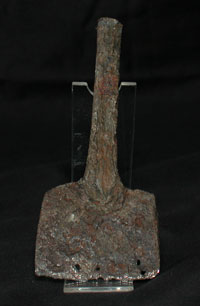(original) (raw)
You are here:
Growth and consolidation (1152-1182)
(1/2)
Iron chisel found at Kirkstall Abbey © Abbey House Museum
 |
|---|
During Alexander’s thirty-five year abbacy (1147-82) the foundations for monastic life at Kirkstall were firmly established. Having successfully organised the community’s relocation from Barnoldswick, Alexander completed the major building work at Kirkstall, brought the land there into cultivation, and began the process of establishing granges.(1) He attracted recruits and benefactors (many from neighbouring places such as York, Leeds, Bracewell and Otley), thereby extending the abbey’s acquisitions. By the end of Alexander’s abbacy Kirkstall had established holdings in all the areas where it would later develop its great estates.(2)
Building work
The lion’s share of the building work at Kirkstall was completed before the end of the twelfth century, and the chief buildings were finished during Alexander’s abbacy (1147-82). The Foundation History of the house explains that the church, monks’ dormitory and refectory, lay-brothers’ dormitory and refectory, chapter-house, cloister and other necessary offices within the abbey were all built in wood and stone, and covered with fine tiles made of fired clay and stone slabs known as ‘thackstones’; remains of both types of roofing material have been found. In the fifteenth century the roofs were recovered with lead sheets.(3) The community quarried Bramley Fall stone, a hard, coarse-grained granite, which was resistant to bad weather. It was transported from quarries across the river. Remains of the wooden jetty where the stone was landed have been recovered, as well as several slabs that must have been dropped during transportation.(4) As Alexander endeavoured to conserve the abbey’s woods, timber was sought elsewhere.(5) The monks and lay-brothers worked together to erect the buildings, and Henry de Lacy himself laid some of the foundation stones in the church, financing the remainder of the work. Skilled stonemasons were brought in to complete the carving.(6) Excavation of the site in the 1950s recovered traces of a twelfth-century forge which may have been used in the construction of the abbey.(7) The building-work was not only laborious and time-consuming, but expensive, and in 1186 Kirkstall was amongst the eight Yorkshire houses that owed Aaron, the Jew of Lincoln, the combined sum of 6400 marks.